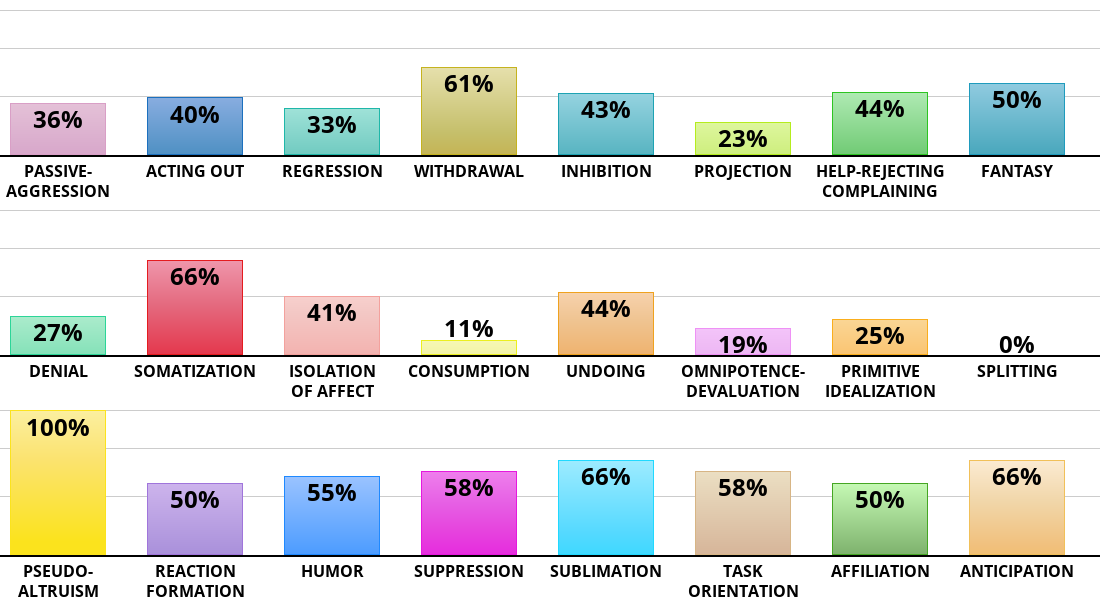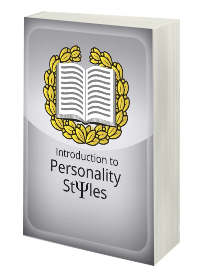Defense Style Test
You are here because one of your friends linked you to their Defense Style Test result:
Take the TestResults:

- Your friend's maladaptive defenses are low (37.07%).
- Your friend's image-distorting defenses are very low (15.15%).
- Your friend's self-sacrificing defenses are moderate (58.33%).
- Your friend's mature, well-adjusted defenses are moderate (58.33%).
- The likelihood that your friend has answered the questions on this test honestly is high (64.81%).
Description of Scales:
Acting Out
Performing extreme behaviors as a means to solve emotional conflicts rather than through inward reflection or feeling. For example, instead of verbally expressing oneself when angry or sad, the person throws a glass, shouts curse words, threatens others, or engages in self-harm.
Passive-Aggression
Behaviors indirectly or implicitly expressing aggression or negative feelings such as annoyance or resentment, often accompanied by a façade of compliance that is really masking covert hostility, resistance, and resentment.
Regression
Reversion to an earlier stage of personality development when experiencing unacceptable or threatening feelings or thoughts. For example, an adult curling up in the fetal position when feeling afraid, or an adult throwing a temper tantrum as if they were a four-year-old when not getting their way.
Withdrawal
Flight-type behaviors, in which a person removes or disconnects themselves emotionally or physically from uncomfortable events, interactions, or stimuli that produce painful thoughts or feelings. For example, a person stays home from work because of a conflict they had with a co-worker the day before.
Inhibition
An involuntary decrease in motivation to engage with an associated anxiety or do something to prevent such anxiety. For example, a person doesn’t read up on their exam, struggles with shyness while trying to meet new people, or eats cake while dieting.
Projection
Attributing unacceptable thoughts, feelings, motives, and traits of one’s own to other people, thus coloring one’s own mistaken interpretation of the other person. For example, a person believes other people are looking at them in public because they themselves feel unattractive or self-conscious.
Help-Rejecting Complaining
Complaining or soliciting help from others, but then rejecting their support as a way of resolving emotional conflict within oneself. Help-rejecting complaining is positively correlated with hypochondriasis, a defense mechanism with which an individual feels that no one understands them, or they exaggerate their circumstances to themselves and others for the purpose of evading accountability or guilt.
Fantasy
Soothing oneself through fantasizing; escaping frustration by substituting the conditions of reality with imaginary satisfaction. For example, a person daydreams excessively about grand accomplishments as opposed to working on furthering their real-world success.
Denial
Rejecting unpleasant experiences by blocking external reality from awareness in order to avoid the anxiety associated with acknowledging objective reality. For example, a person missed out on a major opportunity and now tells themself it was not that big of a deal.
Somatization
A tendency to perceive and communicate intrapsychic conflict as physical symptoms without organic cause in order to avoid intolerable feelings or thoughts. For example, feeling nauseous or ill due to the anxiety associated with an important presentation at work.
Isolation of Affect
Separation of emotion from experiences and ideas so that reality can be accepted without an emotional response since the associated affect is blocked from awareness. For example, describing an acute traumatic event without the appropriate accompanying emotional response, i.e., thinking the feeling without feeling the feeling.
Consumption
Self-soothing of psychological distress through the reliance on external stimuli such as food, alcohol, cigarettes, or drugs. For example, a person breaks up with their significant other, so they eat a tub of ice cream.
Undoing
Engaging in behavior contrary to unconscious, unacceptable, and destructive impulses or thoughts in order to symbolically undo, negate, or make amends. For example, a person feels guilty for being frustrated with a co-worker and buys them a gift to compensate.
Omnipotence-Devaluation
Feeling powerful and entitled, behaving as if one has special abilities or attributes that make one superior to others in order to counter deep-seated feelings of inadequacy. For example, when one person does a good job, and the other person responds by talking about how they would have done better.
Primitive Idealization
Attributing unrealistically positive qualities to self or others. For example, a person puts someone they know on a pedestal, believing them all-good, all-knowing, all-strong, all-patient, etc.
Splitting
The tendency to hold polarized, black-and-white views of self and others when experiencing conflicting feelings. For example, a person’s co-worker, who is usually competent, makes a bad call; so the person now perceives them as completely incompetent and is seemingly unable to recall any of the co-worker’s competencies or reflect on their good and bad sides with nuance.
Pseudoaltruism
Self-sacrificing acts to which there is an underlying, unconscious motivation, i.e., the person undertakes these behaviors to experience gratification from meeting the needs of others so as to cope with their own repressed sadness or rage.
Reaction Formation
Substituting unacceptable or unwanted impulses with diametrically opposed behavior. For example, a man is talking about a subject that makes a woman uncomfortable but, when asked, she says that the topic is actually really interesting to her.
Humor
The ability to perceive comical absurdity, during challenging situations when one is experiencing psychological distress, by emphasizing amusing or ironic parts of the conflict or stressor. For example, a man messes up while giving a presentation but makes this a humorous situation for everyone by pointing out the absurdity of what happened.
Suppression
Voluntary efforts toward compartmentalizing and thus postponing unwanted impulses in order to maintain focus. For example, counting to ten before taking action when frustrated or, in order to concentrate on work, “forgetting” that one’s significant other has been acting weirdly lately.
Sublimation
The transformation of maladaptive feelings and impulses into behavior considered socially acceptable. For instance, doing pushups or going for a run to channel unwanted impulses of frustration after having a fight with one’s partner.
Task Orientation
Focusing on problem-solving or attempts to change a situation for the better to avoid unwanted impulses and feelings. For example, a person is stranded in the wilderness but focuses on getting enough to eat so they can make time in the future for figuring out how to get back to civilization.
Affiliation
Reaching out for support and sharing issues without externalizing accountability. For example, turning to one’s best friend for authentic advice after fighting with one’s partner.
Anticipation
Dealing with distress and stressors by anticipating consequences and the feelings one would associate with future negative events so one can consider realistic solutions and responses. For example, being very sad the days prior to one’s best friend moving in order to alleviate anxiety associated with the final separation.
References
- Manual for the Defense Style Questionnaire (DSQ), Michael Bond, M.D. & Steven Wesley, M.D. 1996.
- Vaillant GE: Ego Mechanisms of Defense and Personality Psychopathology. Journal of Abnormal Psychology 1994.
- Perry JC, Cooper SH: An Empirical Study of Defense Mechanisms. Archives of General Psychiatry 1989.
Take Next
GET THE FULL STORY
Become a lifetime member with a one-time payment
WHAT YOU GET
Access to members-only tests
Ability to track and save test results
Access to all of our eBooks (value $44.94)
Access to premium type assessments and infographics
Become a memberGET THE FULL STORY
Manual of Personality Styles
WHAT YOU GET
71-page manual, explaining the make-up of all personality styles, their hidden drives, and the theory behind the system.
Presented in an easy-to-read style and backed up by solid academic references.
14-day, no-questions-asked, money-back guarantee.
Order NowSave and monitor your results over time
Become a member today
Sign Up












